► Luxury SUV triple test review
► New Q8 battles Velar and Touareg
► CAR magazine Giant Test verdict
Welcome to a test of three cars that, on the face of it, make absolutely no sense. The players in this rather odd match of the best luxury SUVs of 2018: Audi’s new Q8 flagship SUV, which takes the eminently practical but pricey Q7, removes some practicality and adds some cost; the Range Rover Velar, the Kardashianised alternative to Land Rover’s styled-by-function Discovery; and the new VW Touareg, a car with a Volkswagen badge which, as tested, costs more than £70k thanks to Wolfsburg’s inveterate mission creep. What gives?
And if you want an electric SUV, don't miss our separate guide here.
CAR’s guide to:
The SUV’s time as a social pariah has long passed. Now the de facto car genre of choice, it’s proliferating into sub-classes within classes; today one might very likely consider buying an SUV not for practicality, let alone off-road ability, but instead as a vehicle of leisure and prestige, in the same way that people once bought big coupes and saloons.
Luxury SUVs: prices and specs of the cars on test
So, here stand three status-symbol SUVs, each costing north of £70k as tested, each with a 3.0-litre V6 diesel engine, eight-speed auto gearbox and air suspension, and each with a slightly different opinion on what a posh SUV can be: coupe on stilts, style study or computer operating system on wheels (can you guess which one’s which?).
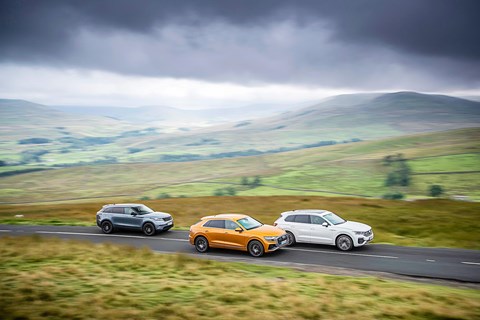
Usually we dive straight into driving impressions, but with these three how they cover ground is not necessarily the most important factor in their appeal; their design and what they offer all occupants in terms of personal satisfaction can be just as decisive. It might not be an enthusiast’s order of preference, but that’s Instagrammy, selfie-regarding, modern life. So these three have a day’s testing to convince us, and you, that they can make sense, in the place where common bloody sense was invented.
Britain's best hybrid cars
Audi Q8: an introduction
I’m in the Audi to get to our Yorkshire Dales test location. It’s the newest car of this luxury SUV crossover trio, and it’s keen to let you know it’s here – and not merely because of its metallic Dragon Orange paint.
Lower, wider and broader of wheelarch, the Q8 is a Q7 given the Snapchat filter treatment, and if you squint you can see similar proportions to Lamborghini’s new Urus SUV, which shares the same VW Group MLB Evo platform (as do the Bentley Bentayga, Porsche Cayenne, the smaller Audi Q5 – and the VW Touareg next to it on these pages). Its octagonal grille is rent wide across its bull-like nose, circled by a big picture-frame border and bookended by two hot hatch-style flared nostrils in the lower bumper.

Only one of those vents is real; the offside one is a blanked-off fake, and so are the full-width vents along the rear bumper. Even the oblong exhaust outlets are plastic mock-ups; the real, metal pipes are actually concealed behind and slightly below them, which feels like a cheap trick for an expensive car, but one perhaps in keeping with the Q8’s style-led approach.
One engine is available from launch with the Q8, the 50 TDI, named according to Audi’s moderately confusing new filing system. Despite the name, it’s a 282bhp 3.0-litre V6 diesel; a lower-powered 228bhp 45 TDI and a 55 TSI (335bhp 3.0 V6 petrol) join the range later.
Likewise, the Touareg is offered only with the same V6 diesel for now, with a choice of two power outputs, 228bhp or 282bhp. The latter’s being tested here.
Range Rover Velar: aluminium lightweight know-how
For a worthy opponent to the Q8, look no further than the Range Rover Velar, if not for driving dynamics than for sheer panache and sense of occasion. Of the three, the Velar has a slight advantage in power with its twin-turbo V6 offering 296bhp, but a detail that might prove crucial later, and certainly denotes the heft on display, is that the Range Rover is usefully lighter than the other two at a still chunky 2029kg.
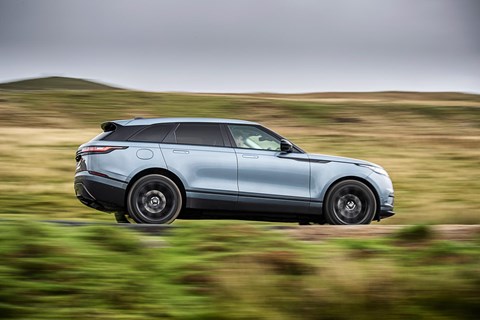
The only truly trad SUV in this test, the Touareg is here as a sense-check for Audi’s flagship flight of fancy. Same platform, identical engine, but offering more space for less cash, it shadows the Q8 like a big white Jiminy Cricket on its shoulder, both its conscience and its judge. Less cash is a relative term though; while Touaregs start from below £50k, this heavily trinketed R-Line is worth £72,975. For comparison, although four-pot Velars begin in the mid-40s, you’ll need nearly £50k to get into a V6 diesel one and this HSE-spec car hits £73k after options. The Audi starts at around £65k but the heavily optioned car tested here costs no less than £85,565.
A domineering design in isolation, parked between the two blinged-out German cars the Velar appears elegant, classy; understated. Almost. Its bluff, upright front is the most aggressive element of its design, but from there back it’s minimal, smooth-surfaced sculpture, flush pop-out door handles and all.
If the Velar is the subtlest car here, the Touareg is emphatically not. Approached from the front, it is apparently composed almost entirely of radiator grille, like a giant Mach 3 razor has been plonked onto it. Like the Audi, many of the spaces between the chrome are blanked-off plastic. Unlike the Audi, it makes no pretence at being a coupe.
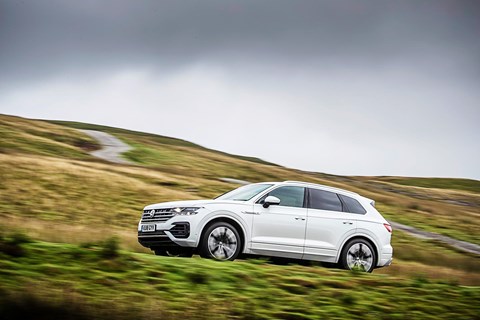
Most SUVs clad their sills with black bodywork to make them appear higher than they really are, but the Q8 (and the Touareg, for that matter) is unashamedly body-coloured from its head to its toes, suggesting this is an off-roader designed to be enjoyed primarily on tarmac. Where the Q8 and Touareg are big slabs of body colour, the Velar makes clever use of colour breaks, using blacked-out sills and D-pillars to give the impression of a tapering tail more akin to a sports car than an off-roader.
Luxury SUVs driving impressions
But what about the substance? Were this test judged on driving experience alone, the Q8 would walk it. Not in the first few miles, perhaps; at first acquaintance the Q8 feels a little remote, anodyne. The steering is light, the single-turbo diesel torquey enough but not particularly charismatic, grumbling distantly like The Fast Show’s Rowley Birkin QC. But as the roads begin to narrow and tangle, its strengths begin to show. Active torque vectoring enables you to pick up the throttle early, get into a flow and cover ground improbably quickly, and actually enjoy the process a little too.
Prodding the touchscreen-sited Drive Select control for Dynamic mode shows the Q8 in its best light. The steering feels more accurate, and its fast rack becomes a real strength. So little lock is required for tight turns you rarely need move your hands from quarter-to-three to point and shoot an apex. That’s partly a function of rear-wheel steering (a £1950 option), an MLB Evo party trick which is at its most agile in Dynamic mode, and feels creditably natural in operation.
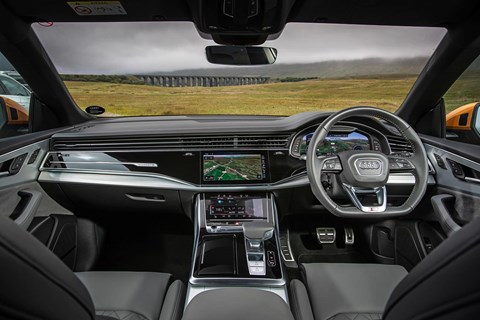
One piece of platform tech conspicuous by its absence, however, is electronic anti-roll control, featured in plenty of its MLB Evo buddies but not available on the Q8 until next year. In fairness, it doesn’t feel like it needs it. The Q8 corners very flat as it is, and body control is exemplary. So is the ride quality on the Q8’s standard air springs, even with this particular car’s huge optional 22-inch wheels (the other two cars are on 21s). There is some light surface patter there, like low-level background white noise, but it’s impressively well disguised.
The Touareg too features air suspension and rear-wheel steering, a £2370 option combined. Its ride height can sit up for obstacles or hunker down for twisting roads, and the Touareg’s bumpers certainly feel less at risk than the Q8’s when we have to engage in a little light bouldering to turn around in a rocky pull-in. The rear-steer is again supremely subtle in operation, tightening this big car’s turning circle without making it obvious it’s doing so.
The Touareg does get the active anti-roll control the Q8 misses out on, and it helps this big car control its bulk with surprising alacrity. It doesn’t make it a match for the Audi as a driver’s car, however; get over-enthusiastic in a slower corner and the Touareg can step on its own toes, feeling more clumsy minibus than high-tech SUV. But then, it is the tallest car in the test, and one that makes no pretence at ‘sportiness’.
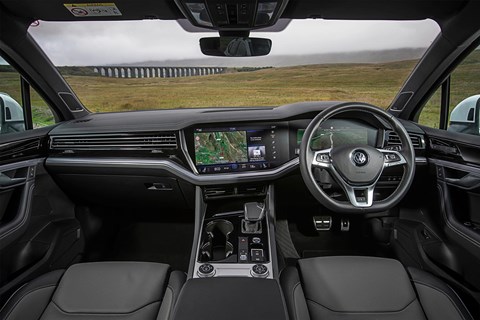
Regardless, it would be nice if the gearbox could try to be a little keener. Downshifts take an age; put your foot down out of a roundabout and go nowhere fast until the transmission finally deigns to give you the gear you really need. The Q8 suffers from the exact same issue; normally the last thing you’d do is use the shift paddles in a big torquey diesel, but you might find you have to in the Audi and the VW to make effective progress.
Ride and handling
The Touareg’s overriding impression, however, is that it doesn’t really need you to drive. Like the Q8, it’s bristling with semi-autonomous assistance tech, that giant grille and windscreen concealing various sensors and cameras, including night vision, which can pick out pedestrians and animals in the darkness and warn the driver they’re oncoming by briefly flashing the active LED headlights specifically in their direction and displaying their image on the digital instrument panel. And the Touareg can theoretically stop, pull away and steer itself in traffic jams at up to 37mph.
The Velar sits between the Q8 and the Touareg for driver appeal; not as sharp as the Audi but slightly more satisfying than the VW. It too is afflicted with a slightly dozy gearbox but otherwise it’s a smooth and quite imperious way to travel. Pedalling it quickly is a bit like how I imagine piloting a powerboat must feel: the prow rises with acceleration as the rear suspension squats, and dips noticeably under braking, discouraging you from dropping anchor late as you would in a performance car.

The Velar wears all-season tyres, unlike the more summer-orientated rubber fitted to the other two cars in this test, which may blunt its handling a little. Although the Range Rover’s electronically controlled air suspension controls its big body’s movements tidily, it doesn’t shrink around you in the same way the Q8 does. It might be smaller than a Range Rover Sport, but the Velar always feels like a big car to drive.
Its real strength is in feelgood factor rather than dynamics. If good design is about good storytelling, the Velar is the full Jackanory. The pop-out door handles’ theatre is echoed by the rising gear selector and tilting touchscreen within, in a cabin cut from the same minimally modernist cloth as the exterior, with clever use of textures, fabrics and contrasting materials. Almost everything you touch in the top half of the interior encourages you to do so; the interior door handles are a particular highlight, feeling like they’ve been milled from a solid billet of aluminium.
Switchgear is minimal, with controls split between upper and lower touchscreens, complemented by a touch-sensitive volume control on the steering wheel. It’s not perfect; the upper touchscreen in particular is frustratingly unintuitive and laggy, and there’s no Android Auto or Apple CarPlay, which seems curious in such an otherwise techy, modernist kind of car.
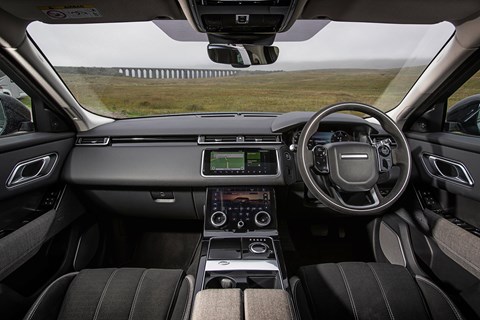
The Audi also features an upper and lower touchscreen set-up. The key difference is in its haptic feedback; the Q8’s screens require a proper prod, almost like pushing a button (remember them?). In some ways it’s safer – for a definite input, you get a definite response, which is surely a good thing when you’re also trying to concentrate on driving two-and-a-bit tonnes of very wide car. On the flipside, it demands you lower your eyes from the road for too long to find your target on the screen’s smooth surface, particularly on the lower screen, which is a mass of same-font, same-colour (white) red herrings.
Browse used luxury SUVs in our Cars For Sale section
Fingerprints: the enemy of touchscreens
It’s also a magnet for fingerprints, so you feel the niggling need to give it a good clean every time you look at it. The same piano-black finish is extended across the dashboard and centre console, including the cupholder cover, which rattled a little in this particular car, and contrasted with aluminium, suede and leather. The incongruous flat-bottomed wheel that looks like it has been borrowed from a supercar is a £375 option.
Where the Q8’s appeal is in brassy style and agile handling, the Touareg’s USP is high-tech infotainment, and the VW’s interior packs a bigger wow factor than the Audi’s in this luxury SUV giant test. This car’s top-of-the-range R-Line trim features what VW dubs the Innovision Cockpit. Sounds like a cross between a Stevie Wonder album and a Science Museum exhibition, but in reality it’s a giant digital display, smushing together the 12-inch digital instrument display behind the wheel with a huge 15-inch touchscreen centre-dash to create one unbroken digital vista. There’s practically no physical switchgear other than on the steering wheel, and a roller volume control down near the cupholders.
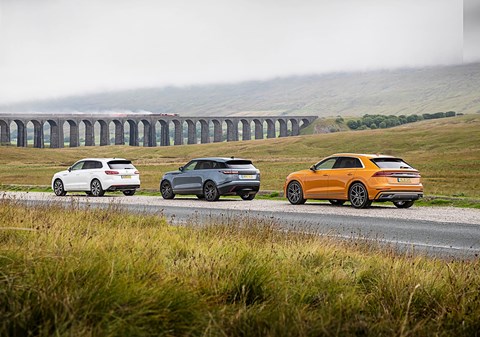
At first glance it makes both Q8 and Velar look a bit old-hat. If you’re a tech magpie this is the car for you. The menus and displays are configurable and you can pull, push and flip shortcuts by pinching and swiping your fingertips on the screen – or in the air, using gesture control for certain commands such as skipping music tracks, which only worked when I didn’t want it to.
Unlike the Q8, the Touareg’s system does at least keep your line of sight nice and high, but I’m still to be convinced it’s not a distraction. The wealth of information on display is dizzying, and it takes time to configure to your liking and get the best from it. A particular party trick is the ability to display giant Google Earth 3D map graphics on both screens, which can become divertingly fascinating: ‘What’s that big building on the left behind the trees? I never knew that was there…’ Good job the Touareg can pretty much drive itself. The tall, un-sporty shape means interior space is quite epically vast.
Despite the VW body’s size there’s no seven-seat option, which means endless legroom for five and comfortably the biggest boot (although this car’s £1260 panoramic sunroof option does eat a fair bit of headroom). The lower-roofed but lengthy Q8 and Velar are still plenty practical though and they don’t exactly lack for interior and luggage space.
Britain's best luxury SUV: verdict
The Touareg is supremely refined and bristling with wow-factor tech. But it’s big money for a car with a VW badge, and we’ve seen how that’s ended before. The Audi Q8 is the best car to drive, and an office straw poll suggests its exterior design is a hit. But parked next to the Velar it appears fussy and overwrought. There’s substance to the Velar’s laconic, handsome style, and its sheer feelgood factor wins out. Not particularly enjoyable to drive quickly but wonderful for relaxed progress, it’s a car in which to indulge yourself and enjoy every moment. It's our best luxury SUV of 2018.
More group test reviews by CAR magazine